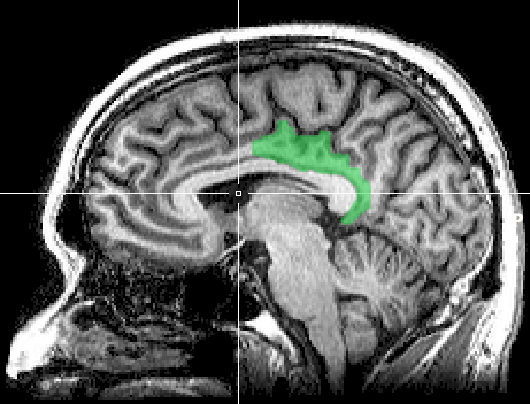
From the Neuroskeptic blog at Discover Magazine, this is a cool article describing a new discovery a small region in the brain (in the white matter beneath the left posterior cingulate cortex [PCC]) that when stimulated creates a state of dissociation that is experienced as a dream for the person whose brain has been stimulated. Very interesting stuff.
Full abstract for the original article - the article itself is behind a paywall.Disconnecting Consciousness from the External Environment
By Neuroskeptic | February 23, 2014
An very interesting report from a group of French neurosurgeons sheds light on the neural basis of consciousness and dreams.
Guillaume Herbet and colleagues describe the case of a 45 year old man in whom electrical stimulation of a particular spot in the brain “induced a dramatic alteration of conscious experience in a highly reproducible manner.”
The man had brain cancer (a diffuse low-grade glioma of the posterior left hemisphere). During the surgery to remove the tumour, Herbet et al stimulated various points on his brain to map out the areas that were functionally most important. This is a standard procedure to allow surgeons to know which bits they ought to leave intact, where possible.
Most of the stimulations didn’t do much, but there was a particular point, in the white matter beneath the left posterior cingulate cortex (PCC), where the electrical pulse caused the patient to become unresponsive – to ‘zone out’, essentially – for a few seconds. This point is marked as “S1″ (small blue spot) on these images. The red zone on the left is the area that was eventually removed.
Upon regaining awareness after the stimulation, the patient reported that he had been ‘in a dream’. Three stimulations of the same area produced three such reveries:
Quite surprisingly, he described himself retrospectively as in a dream, outside the operating room, and was able to fleetingly report his subjective experiences (stimulation 1: “I was as in a dream, there was a sun”; stimulation 2: I was as in a dream, I was on the beach”; stimulation 3: “I was as in a dream, I was surrounded by a white landscape”. No additional sites in the surrounding anatomical space were found to elicit this manifestation.Suns and beaches doesn’t sound like the stuff of nightmares. But the patient said that these dreams were, in fact, unspeakably horrible:
However, the simple mention of the event was associated with a strong emotional discharge, including crying and tremors, and finally the patient always said: “I don’t remember, I don’t want to remember”All very gothic. But what does it mean? Herbet et al say that
Disrupting the subcortical connectivity of the left posterior cingulate cortex (PCC) reliably induced a breakdown in conscious experience.Which fits with the theory that the PCC – a ringleader of the brain’s default mode network – is central to waking consciousness. But what’s odd is that a large chunk of the left PCC was not just disrupted but permanently cut out, and it didn’t destroy the patient’s consciousness – although
He reported experiencing no rumination and no negative thought for almost a month after the surgery. He described himself in a kind of contemplative state, with a subjective feeling of absolute happiness and timelessness.Sounds almost like spiritual enlightenment, but it only lasted a month; after that, it seems, he returned more or less to normal consciousness – even thought that chunk of PCC was still gone. So I’d say this case report, while fascinating, raises more questions than it answers.
Full Citation:
Herbet G, Lafargue G, de Champfleur NM, Moritz-Gasser S, le Bars E, Bonnetblanc F, & Duffau H (2014). Disrupting posterior cingulate connectivity disconnects consciousness from the external environment. Neuropsychologia, 56C, 239-244 PMID: 24508051
Disrupting posterior cingulate connectivity disconnects consciousness from the external environment.
Neuropsychologia. 2014 Feb 4;56C:239-244. doi: 10.1016/j.neuropsychologia.2014.01.020. [Epub ahead of print]Abstract
Neurophysiological and neuroimaging studies including both patients with disorders of consciousness and healthy subjects with modified states of consciousness suggest a crucial role of the medial posteroparietal cortex in conscious information processing. However no direct neuropsychological evidence supports this hypothesis and studies including patients with restricted lesions of this brain region are almost non-existent. Using direct intraoperative electrostimulations, we showed in a rare patient that disrupting the subcortical connectivity of the left posterior cingulate cortex (PCC) reliably induced a breakdown in conscious experience. This acute phenomenon was mainly characterized by a transient behavioral unresponsiveness with loss of external connectedness. In all cases, when he regained consciousness, the patient described himself as in dream, outside the operating room. This finding suggests that functional integrity of the PPC connectivity is necessary for maintaining consciousness of external environment.

No comments:
Post a Comment